Stepping into retail real estate development could be a start of positive cash flow and help you gain financial freedom and stability.
You may be thinking of sinking some money into developing a retail property. If so, there are a few things you'll want to keep in mind. Like any other real estate investment, there are risks involved in retail development - but if you're aware of these and plan accordingly, you can minimize your losses and make a healthy return on your investment.
Here are the most important things to consider when planning a retail development project.
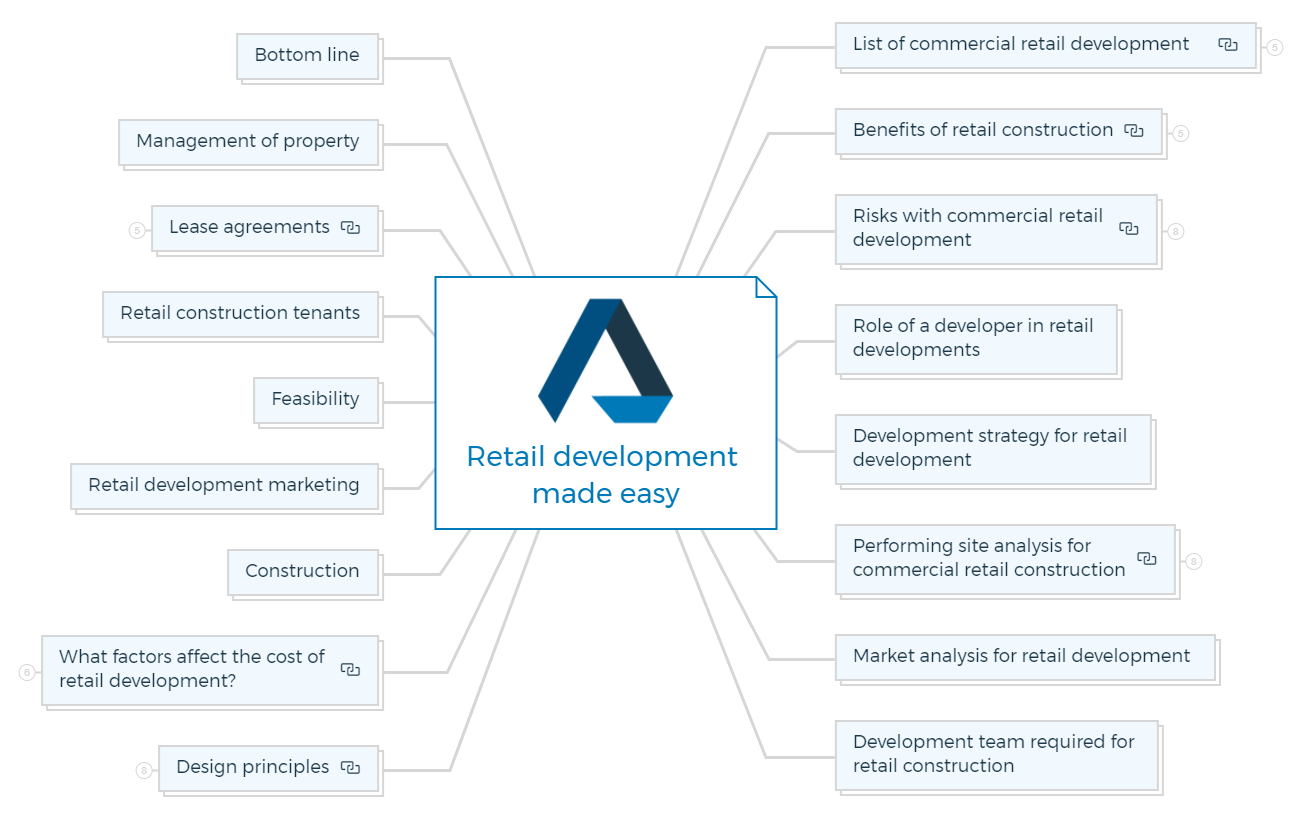
List of commercial retail development
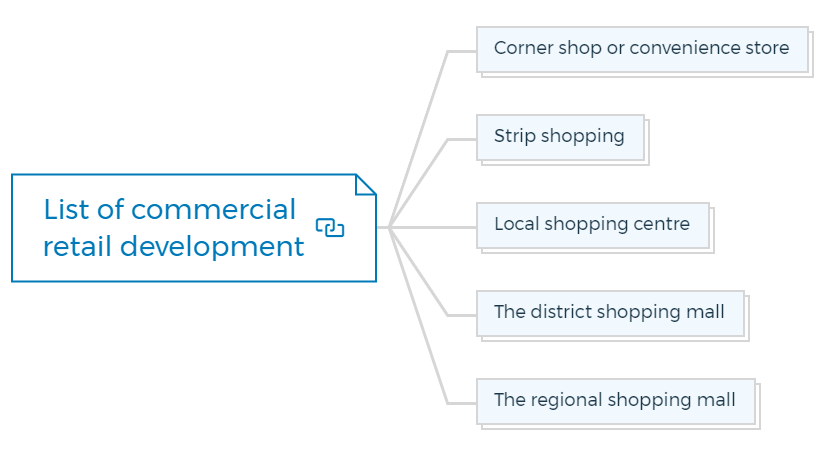
Corner shop or convenience store
This retail development is basically a conventional corner convenience store found in older suburban areas.
Strip shopping
It refers to a continuous row of stores that are typically located along main arterial routes.
Local shopping centre
Refers to a neighbourhood retail centre containing one significant anchor tenant, such as a supermarket and several smaller line stores.
The district shopping mall
Features an anchor tenant, usually a junior department store, and may also include banks and professional offices.
The regional shopping mall
Is constructed with one or more major department shops and comprises general items, clothes, and service firms.
Larger retail centers are typically built by experienced, skilled, and financially able development companies or experienced property developers. However, inexperienced people or small syndicates can develop corner convenience stores, strip shopping, and neighbourhood shopping centres.
These larger centres necessitate in-depth study, astute planning, sound financial structures, various lease alternatives, and experienced management. While each of these groups has its features, they all follow the same basic rules for development and finance.
Benefits of retail construction
Developing a retail shop can be thrilling and lucrative, and the following are some of the most significant advantages.

Possibilities for monopoly
Monopoly prospects arise if no other land in the neighbourhood is available for another competing retail centre.
Capital growth
As is the case with most commercial property, the buildings' value goes up as the rent goes up. Also, because these developments have longer leases, commercial properties tend to have more long-term growth potential than residential properties.
Potential for cash flow
Tenants are often responsible for most operational and advertising costs and outgoings.
Care by tenants
Tenants often take care of the property since they have to find ways to preserve or improve their business standards.
Financing is simple
If the correct location is discovered, essential tenants are signed to long-term leases, and a realistic return is assessed, financing is usually easy to come by.
Risks with commercial retail development
Retail centres, like all other developments, carry several risks. They also have their own set of issues, such as:

Inefficient land use
You can not utilise a large amount of development land for building due to parking restrictions in retail centres.
High land prices
The scarcity of developable land within an established neighbourhood and inefficient land usage due to parking needs are all factors that contribute to high land costs.
The size of the development finance
A large-scale structure with high-quality finishes to lure customers to the centre necessitates a more significant financial investment.
Failure of a tenant's business
According to statistics, many new firms fail in their first few years, and new retail centres appear to attract these tenants.
The possibility of new centres opening
New nearby shopping centres bring new competition and may be able to entice your customers and critical tenants by giving favourable lease terms.
Requirement for high management
Tenant requests, high maintenance levels, security, and promotions necessitate an expert's full-time administration.
Tenant issues are more likely to arise
Tenant complaints arise due to business challenges, rental increases, and tenant competition within the same centre.
Possibility Of obsolescence
Retail buildings must always stay up with current architectural ideas and finishes to attract customers, especially in high-traffic regions.
Role of a developer in retail developments
Retail real estate development will begin with a developer seeking a site. The satisfying return on capital investment attained by acceptable rental payments from tenants will be of concern to the experienced developer who has an established team and is seeking locations.
When a developer is also a contractor, they may get a greater return on investment through better pricing and cost savings. Developers usually provide the shell of the shopping unit, while tenants are responsible for the interior finishing and fit-out, including shopfronts.
The developer may need to give additional finishes or specifications for larger stores to attract significant tenants.
The job of a retail centre developer is complex, and one component of the job that is sometimes overlooked is the difficulties that arise while interacting with people.
Managing many consultants, contractors, retailers, and customers takes a lot of patience, diplomacy, and tenacity. Successful developers have accumulated these 8 attributes - albeit at a high cost in terms of commercial development experience and broad understanding of design trends, development management, and leasing.
To be successful in retail development, you must first work for several years under the supervision of an experienced developer before branching out on one's own. When a new retail developer goes it alone, they are sure to make blunders that one can fix only with the subsequent store development or through pricey repairs.
Don't worry, I know you don't know what to do right now, but that's what I am here for. To help you become a successful developer, I have prepared structured property development courses.
Just go through them, select one according to your knowledge level, and you will travel your real estate success journey with me .
Development strategy for retail development
A private individual or company and an institutional investor or developer, such as an insurance company, can build a retail centre. The latter will supply all necessary skills and funding and take all the required risks.
Because their approach is built on a long-term investment, any financial loss is typically recouped over the years; these institutions are better positioned than most to construct large-scale centres.
Private developers should be more cautious while working on these projects because their financial leverage makes them more sensitive to any mistakes.
Suppose the private developer does not want to hold the building for the long term but instead plans to develop and sell it to a significant investment institution. In that case, they can make a substantial profit by adequately managing the development.
These financial organisations are willing to pay a higher price if the centre is well-located and the developer is willing to assume the risk (rather than themselves). The private developer should aim to sell the property before the building begins to reduce the risk.
Finding the best location for retail construction
Consider the below factors while determining the best location for retail development:
- Distance and time required to travel
- Consumer perceptions of time spent travelling.
- Highway patterns
- Visibility
- Relation to other centres
- Expansion in the future
- The vacancy rate in surrounding cities
- Patterns of consumer retail spending
Performing site analysis for commercial retail construction
Because commercial retail construction needs a significant amount of capital, one must carefully address many factors connected to the site and proposed structures. The following are some of them.
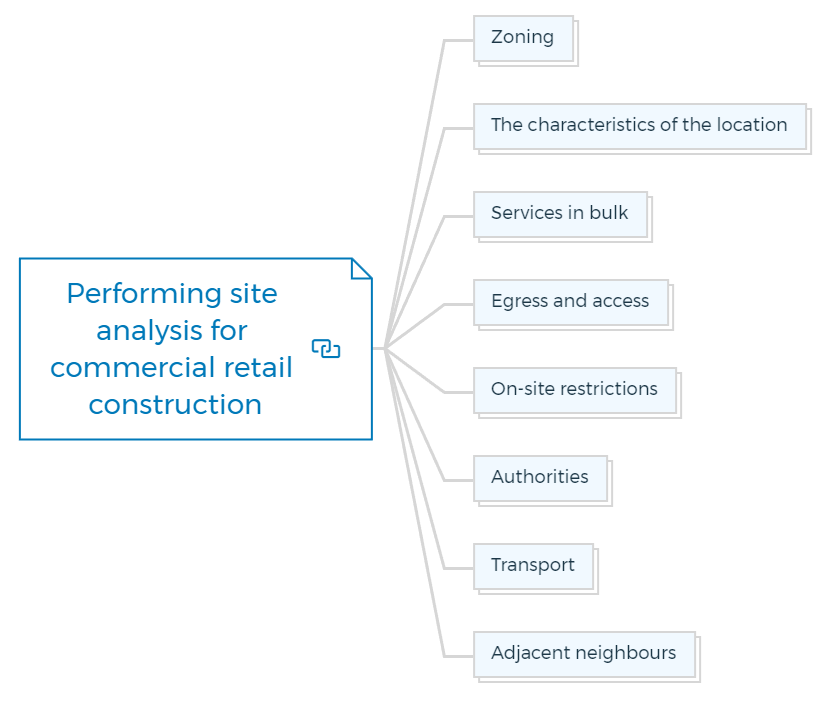
Determine whether the property is already zoned for retail use. If not, figure out how long rezoning will take and how much it will cost.
The characteristics of the location
The soil characteristics fall (or slopes) over the site, existing plants and trees, and stormwater run-off are all factors to consider. You'll need to determine whether you can implement the design in the current environment.
Services in bulk
Check if essential utilities including water, sewage, roads, telephone, gas, and power are available. If not, what is the cost of installation?
Egress and access
Determine whether the place is accessible from the main thoroughfare. Is the current site entrance and egress by appropriate traffic design, and is it user-friendly?
If this is not the case, is it necessary for the developer to conduct a traffic effect analysis and rebuild and reconstruct a new road plan?
On-site restrictions
Determine whether the property has easements, covenants, zoning limitations, or land rights and how to remove them if they interfere with the design.
Authorities
Determine whether other authorities control the place besides the typical local council.
Transport
Investigate the area's public transportation options. Is the site conveniently positioned near a train station or a major public bus route?
Adjacent neighbours
Examine the zoning as well as the existing land use and structures. Will the new centre impact the present residents' lifestyles and comfort?
Ensure you are following this site acquisition process when acquiring sites for property development.
Market analysis for retail development
Many factors must be considered when evaluating the viability of retail development. An experienced professional should do a market study that includes the following:
- The establishment of a catchment area (that is, the number of consumers within a specific area who will use the shopping centre facilities)
- An examination of household spending in the catchment area
- Inside the catchment area, an analysis of projected population trends and income predictions
- A traffic study to assess the length of time it takes to go from the suburbs to the city centre by vehicle or public transportation.
- An investigation on the types of large and specialty stores that are most needed in the area
- A study of the proposed centre's impact on existing trading patterns in the area
- The closeness of competing stores within the catchment region and their impact
- A study of possible sales/volume over ten years
- A comparison of rental rates in the catchment area
- The planned development's retail floor area needs are being assessed.
The examination of these factors demonstrates if the planned shopping centre is required. A new location may offer potential in many circumstances, but one can determine whether the centre should be created later or in stages with this knowledge.
Property Development Checklists
Stop Second-Guessing Yourself
POWER BUNDLE
Finally! A way to Free your mind from worrying
about every possible expense that could derail your project.
3 x Powerful & Detailed Checklists
Compiled Over 10 Years Of Hands-On Experience
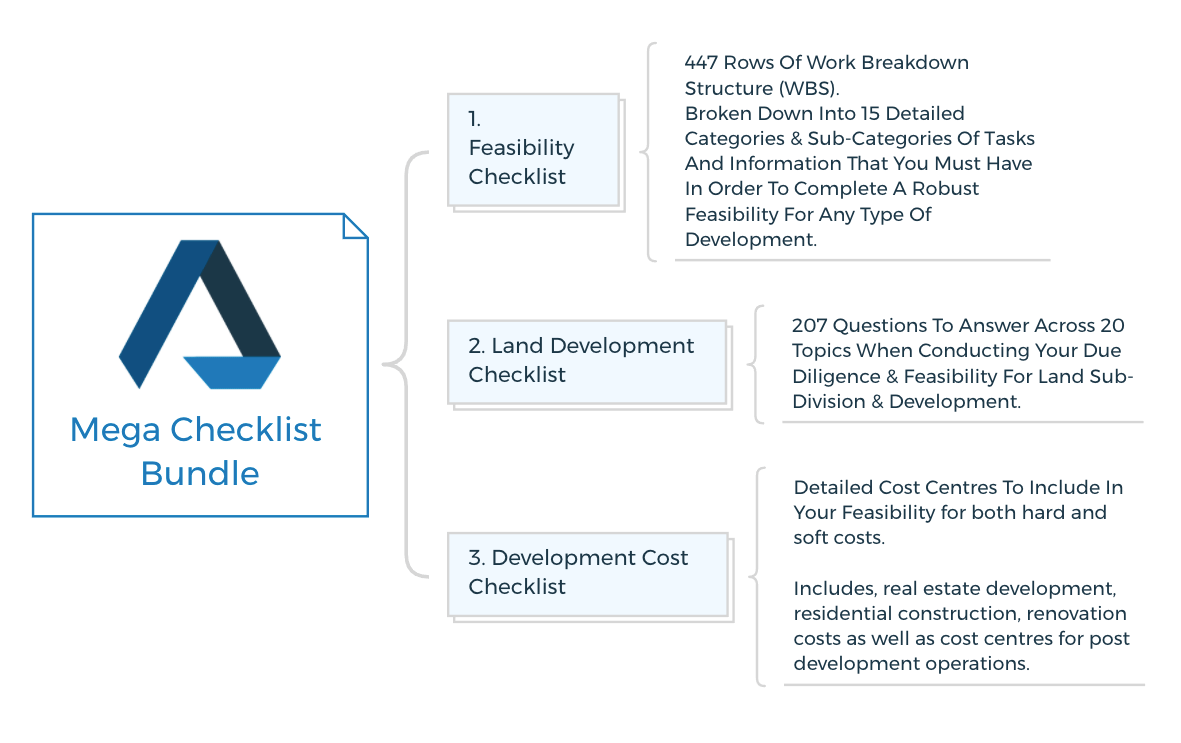
Mega Checklist bundle
✓ Feasibility Checklist
✓Land development checklist
✓Development, Construction & operational Costs Checklist
✓ 447 Rows Of Work Breakdown Structure
✓ 232 Costs To Consider Just On the Developer Side
✓ 524 Cost centres to consider on the construction & remodelling side
✓ Detailed operational costs
✓ 26 Revenue & 78 Expense Items To Consider
✓ Commercial (Retail, Office and Industrial) Side
✓ 31 Revenue & 138 Operating expense heads to consider
Development team required for retail construction
The development team should be made up of a small number of specialists with solid management abilities. They must accept responsibility for their actions and provide good project direction. No one member of the team should dominate the others.
This is especially true in cases where the architect has strong design ideas that consumers and tenants may not well receive. The team should pay special attention to the locals' attitudes, tastes, and buying behaviours.
The following consultants may be considered members of a development team:
- Development manager
- Architect
- Quantity surveyor
- Civil engineer
- Structural engineer
- Mechanical engineer
- Electrical experts
- Traffic engineers
- A lawyer
- An accountant
- Leasing agent
Check out Property Development Team - An army of 23 Professionals to understand the role of all the team members.
Design principles
Certain key design concepts are required to plan and design a retail development. Developers must guarantee that these values are maintained and are not influenced to the contrary by architects or other consultants who may have their own opinions.
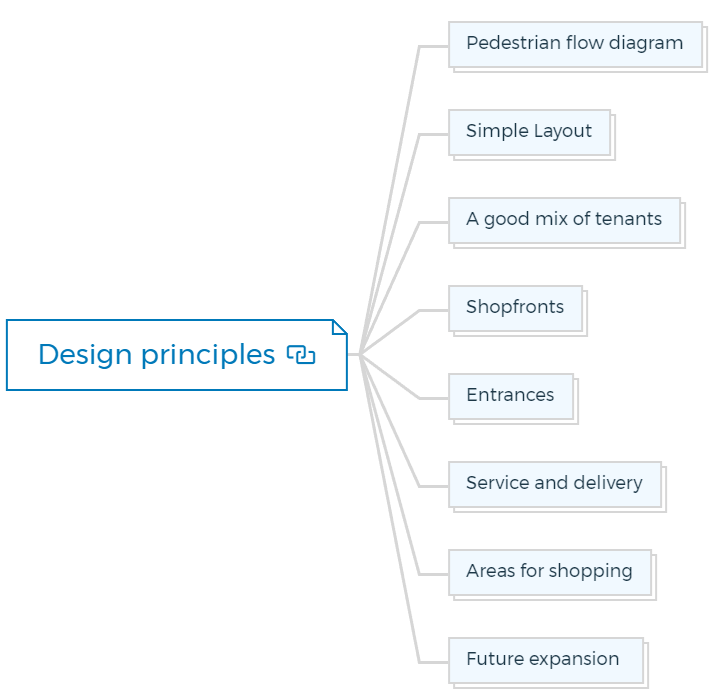
Pedestrian flow diagram
A defined pedestrian flow is undoubtedly the key to a successful shopping centre plan. It is impossible to overstate the significance of this. The optimum program will promote a high level of pedestrian traffic throughout the entire centre.
This will not only maximise rental possibilities, but it will also generate the busy, energetic environment that many great shopping centres possess.
Simple layout
Keep the planning basic so pedestrians can see where they're going and where certain establishments are located. You should understand that shopping can be exhausting, and rest stops should be provided along essential routes.
According to research, customers are only willing to walk a maximum of 250 metres from one spot to another before losing interest.
A good mix of tenants
This is a concept in which tenants in similar trades are clustered together to increase pedestrian circulation. In a shopping centre, tenant competition is encouraged, but excessive competition might suffocate the centre's mission.
Shopfronts
Try to give individual tenants' storefronts some leeway in displaying their merchandise and company identity. If no inventory is shown, shoppers' attention will wane, and adjacent tenants will suffer.
Bank and supermarket storefronts, for example, should be kept away from the pedestrian route's main body. These tenants are referred to as 'destination' stores because they are usually found at the end of a course.
Entrances
Pay utmost attention when considering the location and design of the centre's entrances. They should be immediately identifiable from the outside, have enough shelter to protect against rain, and not be situated in the direction of prevailing winds.
Service and delivery
Carefully examine the delivery and service sections' layout and location. Providing service at the back of each business can be costly in terms of land costs and ugly from all angles.
Although all significant stores must have their off-loading locations, other retailers can share rooms, hoists, and hallways to accept their deliveries.
Areas for shopping
Establishing a maximal trading presence to develop an economically thriving centre is desirable, making store frontage a premium. Shops planned out in an unimaginative and stereotyped structural grid frequently result in several stores having the same space, depth, and exposure.
It's important to remember that various traders require varying amounts of space, and one can attain fantastic rentals by allowing for flexibility in frontage lengths.
Future expansion
A thriving shopping centre will almost certainly necessitate future development, therefore make provisions in the design for this as much as possible.
Inadequate and cumbersome parking can irritate a shopper before entering the main building and negatively impact the customer. Parking should be free or inexpensive, handy, and sufficient, and should be designed to minimise walking distances to the main entrances.
What factors affect the cost of retail development?
Aside from the usual site and commercial construction costs, retail shopping complexes incur additional expenses not often connected with other types of development. You'll find a list of these factors below.
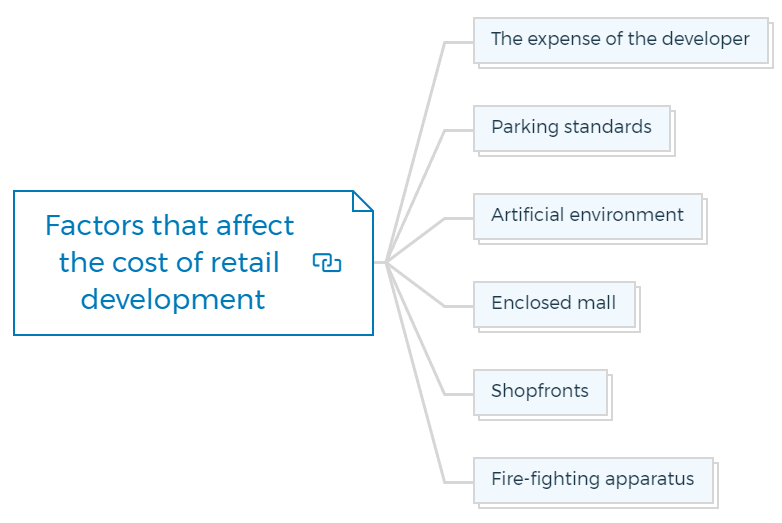
The expense of the developer
Shopping malls attract many pedestrians and motorists, causing local traffic and road patterns to shift. The developer must complete a traffic impact analysis to recommend the current road system changes.
Unless the developer has bargained with the local authorities, the developer usually handles these fees. Additional costs may be incurred, such as the bulk provision of other necessary utilities like water, electricity, and gas.
These services are billed directly to the landlord in more immense shopping centres that are not strata-titled, who, in turn, metres each tenant's consumption and bills them appropriately.
Learn More
Parking standards
Because the municipal authorities set forth strict parking rules, parking and traffic circulation are essential costs in a shopping development. When land is scarce, providing such facilities might be prohibitively expensive, particularly if a multi-level parking area is required.
Artificial environment
Shopping convenience is a must in any shopping centre design. With hot summers, developers must take in the cost of air conditioning and ducting installation.
Enclosed mall
Artificial ventilation becomes a vital issue in enclosed malls; yet, to provide the right shopping experience, developers must spend a significant amount of money on the mall's quality and effect, including high finishes, bright lighting, seating, landscaping, and promotion spaces.
Shopfronts
To achieve the desired street appeal, the developer must direct his architect to construct appealing and eye-catching shopfronts and entrances in both enclosed and open malls.
Because large window areas can be costly, some developers offer a conventional shopfront a deposit and then charge the shop owner for any additional costs spent due to the tenant's requirements.
Fire-fighting apparatus
The provision of fire-fighting equipment becomes an expensive need for the developer because shopping malls are public facilities with significant numbers of people utilising them at any given moment. Sprinkler systems, fire hydrants, and fire barriers are examples of this.
Construction
Management throughout a retail project's construction is crucial. Most retail building contracts always limit the construction programme to a reasonably tight timeframe.
The expensive cost of financing, the requirement to meet tenants' lease conditions, and, typically, the centre's need to open before a critical holiday period such as Christmas or Easter are all driving pressures for rapid development.
If an unskilled builder or project manager is hired, these problematic conditions might lead to various blunders. The experienced project manager will be able to lead and coordinate the professional team by ensuring that all paperwork is provided on time to the builder and that the builder has a few reasons to be late.
Another significant consideration is the coordination of tenants' particular requirements and varying occupation dates, as any delays might lead to difficulties between the developer and the tenant.
Retail development marketing
Marketing a retail development begins as soon as an option to purchase is concluded. The developer's (or the developer's agent's) informal relationships, which can include big national groups and credible local enterprises, begin the acquisition of critical tenants and the marketing of the property quietly.
Attracting significant, high-profile corporations early on is beneficial to the development's success. The marketing material utilised at this stage is not complicated, but it should depict the planned development's location and the overall project concept.
As the project advances, the next step will be to create a comprehensive marketing strategy, which will include the hiring of the following individuals:
- Marketing agencies
- Public relations officers
- Leasing brokers
- Designers of brochures and billboards.
A well-designed brochure will help lease agents, but the broker also needs technical data. This should include information such as the population of the catchment region and the shopper profile, as well as statistical data and descriptive content of relevance to the prospective renter.
The catchment area can be divided into primary, secondary, and peripheral zones. The value of these zones can differ significantly between centres located in well-established neighbourhoods and those set to be built in newly created suburbs. The shopper profile would be divided into income and purchasing power.
Feasibility
The supply, demand, and cash-flow analyses used in the feasibility studies of a retail project are the same as those used in other types of development. However, with retail buildings, the developer must also consider additional aspects such as tenant mix, image, competition, and location, related to consumer requirements and perceptions.
It is vital to assess whether there is an existing and substantial trade area from which potential tenants can pull customers before developing a shopping project. A professional research firm is usually in charge of establishing a trade area, and they may apply some formulas or use feasibility tools to determine the need for retail space.
Retail construction tenants
After determining the centre's size and type, it's time to approach and select the primary tenants, such as department shops, specialty stores, and supermarkets.
A well-built centre with lousy tenants will be a financial disaster, yet a poorly constructed structure with good tenants can still be profitable. Keep an eye out for tenants that are:
- in a stable sector and avoid short-term ones - Credit bureau checks (with the tenant's approval) will help
- well-established firms, especially national brands.
Lease agreements
The developer will find that the final lease conditions for larger key anchor tenants and smaller satellite lessees will differ dramatically. The larger key tenants can get more significant concessions because the developer needs their store to get financing and function as a draw for the smaller satellite stores.
You should consider the following factors -
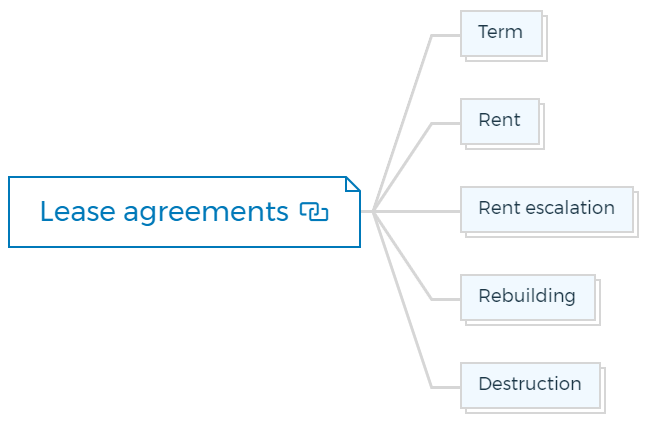
Term
If possible, leases should be for a more extended period.
Rent
Obtain a rent that is both commercially and market-acceptable.
Rent escalation
Aim for the highest possible increase, but make sure it's at least market-acceptable.
Rebuilding
There should be a clause of rebuilding and renovation.
Destruction
There should be a clause protecting the developer from fires and natural disasters.
Management of property
Management is perhaps more critical than in any other construction type. A shopping centre's management is a specialised field, and some of its procedures are radically different from typical management concepts used in other commercial and housing buildings.
Traditional management principles are concerned with the building's operating and maintenance features. A shopping centre's property management, on the other hand, must concentrate on public relations, leasing, and promotions. As a result, hiring property managers with experience and a proven track record is critical.
MEGA DEVELOPMENT COSTS CHECKLISTS
End-To-End Property Development Cost Checklists
Includes both hard and soft costs, as well as detailed residential construction & renovation costs, so you never miss anything.
Bottom line
Building a shopping center or retail center can be exciting, innovative, and challenging. With tight schedules to accomplish, unrealistic tenant demands, and significant capital investments, this type of project requires a lot of dedication and skill.
Before embarking on a retail development project, make sure you have the appropriate management skills, financial resources, experienced consultants, and a thorough understanding of the development process and the roles of the many stakeholders.
At last, I will always be watching your back. You can join my real estate mentoring program, where I can assist in executing your development project.
FAQs
What are commercial retail construction projects?
Small stores inside strip malls and malls to large retail spaces and independent stores are examples of a retail construction project. At the same time, design and marketing consistency is essential for franchises and numerous locations.
It replicates changes at the corporate headquarters in refreshes, reconstructions, and interior improvements at all locations. Every retail development project is unique, and various factors influence the outcome.
What are the benefits of retail development?
Retail development provides a number of benefits for local communities.
First and foremost, retail development creates jobs and increases economic activity. This not only helps to stimulate the local economy, but also helps to create a stronger tax base that can support important public services.
Retail development also results in increased traffic and pedestrian activity, which can be beneficial for local businesses and help to create a more vibrant and lively community. And finally, retail development can help to attract new residents and businesses to an area.
What are the different types of retailers?
There are many different types of retailers, but some of the most common include:
* Department stores: A department store is a large retail establishment that sells a wide variety of products, typically including clothing, cosmetics, furniture, and home appliances.
* Discount stores: A discount store is a type of retailer that offers lower prices on merchandise than traditional retail stores.
* Grocery stores: A grocery store is a type of retailer that specializes in selling food and household items.
* Specialty stores: A specialty store is a type of retailer that specializes in selling products that are not sold in most other retail outlets.

